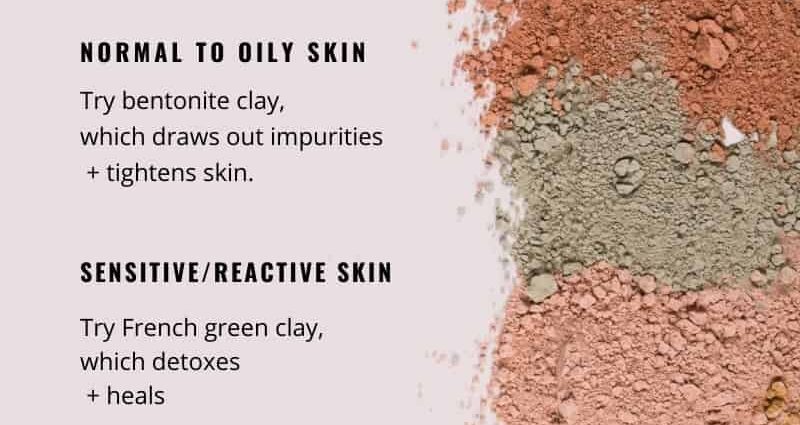Contents
Where to find clay?
No need to dig your garden! Buy your clay in pharmacies, drugstores or specialized organic and dietetic stores. Make sure it is 100% natural, sun dried and free of dyes and preservatives, non-ionized. The one you find most easily is green clay. It is indeed the one that is the most marketed.
Clay is a very economical product, especially if you buy it raw. In “ready to use”, it is still much cheaper than most cosmetics. It can be sold in powder, paste, pieces. You can find it at all prices. The price varies according to the brands but also according to its purity or if it is ready to use for masks or treatments. In addition, you will find a good number of clay-based products: shampoo, toothpaste, depilatory cream, masks, etc.
Clay, a natural beauty product
The argument should appeal to the most organic of moms. Nothing is more natural than clay! An earthy sedimentary rock, whose properties and color (green, white, pink, etc.) vary depending on the minerals it contains. Beyond its physical merits, clay is an “intelligent” product, which activates when wet and naturally focuses on the “problem”. Rid the epidermis of its impurities and toxins, dry out pimples, heal and disinfect, promote the reconstitution of damaged tissues … nature is well done! We get the clay in dry powder, which swells in water to form a smooth paste, or in a tube already ready for use. An ideal texture to apply as a mask or poultice, combined with a few drops of vegetable oils or essential oils for better efficiency on the skin and scalp.
Beauty: my clay recipes
Discover our homemade clay recipes to purify your face, your body and sublimate your hair.
For a purifying mask: mix 5 tablespoons of green clay, 2 tablespoons of hazelnut oil and a little water. Apply the preparation to the face and neck, avoiding the eye area. Leave this clay mask on for 30 minutes. Then rinse it off with lukewarm cold water. Twice a week maximum. The plus: use floral or mineral water, less calcareous.
In body care, you can also take green clay baths for soft skin.
For an exfoliating mask : mix a teaspoon of ultra-ventilated green clay and a teaspoon of lavender honey. Then apply the solution on the face and leave on for 20 minutes. Rinse with clean water without rubbing.
My hair mask: mix the clay powder with an egg yolk and a little mineral water. Apply to the scalp 20 minutes before a mild shampoo. Dandruff ? Add a tablespoon of sweet almond oil, a few drops of thyme, lemon and tea tree essential oil and leave for half an hour. The +: use a wooden or porcelain container and spatula, but no plastic or metal that could alter its composition.
Make yourself beautiful and take care of yourself
These are not just grandmother’s remedies … As a poultice (a compress impregnated with liquid clay), green clay works wonders on muscle and joint pain. Think about it! In case of superficial burn, scratch or shallow cut, infected pimple … you can directly apply a small touch of clay to accelerate healing. It will also be effective in relieving children’s bumps. But anyway, do not use the clay for more than 20 consecutive days without taking medical advice.
To each type of skin its clay
Depending on your skin type and the desired action, choose the clay that suits you best, even if it means having plenty of it in your cupboards to alternate according to the seasons.
Green clay (combination to oily skin, oily hair) : Rich in calcium, magnesium, potassium, etc., it is the most frequently used for its disinfectant and purifying properties. As a mask on the face, it absorbs and regulates excess sebum, responsible for acne and blackheads. It is also effective on hair that has a tendency to grease. Green clay can also overcome persistent dandruff.
White clay (or kaolin) (sensitive, dry or irritated skin, dry hair) : Softer than green clay, it is said to be concentrated in silicas and remineralizing. White clay is ideal for gently cleaning the skin, eliminating its toxins. As a mask, it revitalizes dry and damaged hair. It is also used in talc for babies.
Red clay (normal to sensitive or even irritated skin) : Renowned for improving blood circulation, red clay owes its color to its high iron content. Packed with trace elements, it is ideal as a mask to restore radiance to a dull complexion. It is also known under the name of “Rhassoul” (red clay from the Moroccan Atlas), used since the dawn of time. It cleanses the skin, softens it, tightens the pores and gives shine and volume to the hair.
Yellow clay (mature skin, very sensitive skin, fragile and brittle hair) : Concentrated in minerals, it helps re-oxygenate cells and tones the skin. As a hair mask, it strengthens and stimulates fragile hair.
Pink clay (irritated, sensitive and reactive skin) : Although pink, this clay erases irritation and redness from delicate skin. A soothing and softening treatment, perfect for those who tend to diffuse redness. Rich in trace elements, it gently restores radiance.
Blue clay (all skin types): Rarer on the market, this oxygenating earth is ideal for eliminating impurities. It brings radiance and luminosity to the dull complexion of smokers or people living in a very polluted atmosphere.










